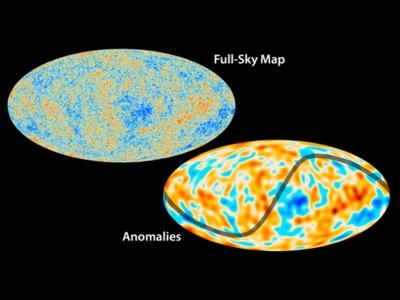Called 'The Best Map Ever Of The Universe'
The Planck space mission has released the most accurate and detailed map ever made of the oldest light in the universe, revealing new information about its age, contents and origins. Planck is a European Space Agency mission. NASA contributed mission-enabling technology for both of Planck's science instruments, and U.S., European and Canadian scientists work together to analyze the Planck data.

The map results suggest the universe is expanding more slowly than scientists thought, and is 13.8 billion years old, 100 million years older than previous estimates. The data also show there is less dark energy and more matter, both normal and dark matter, in the universe than previously known. Dark matter is an invisible substance that can only be seen through the effects of its gravity, while dark energy is pushing our universe apart. The nature of both remains mysterious. "Astronomers worldwide have been on the edge of their seats waiting for this map," said Joan Centrella, Planck program scientist at NASA Headquarters in Washington. "These measurements are profoundly important to many areas of science, as well as future space missions. We are so pleased to have worked with the European Space Agency on such a historic endeavor."
The map, based on the mission's first 15.5 months of all-sky observations, reveals tiny temperature fluctuations in the cosmic microwave background, ancient light that has traveled for billions of years from the very early universe to reach us. The patterns of light represent the seeds of galaxies and clusters of galaxies we see around us today. "As that ancient light travels to us, matter acts like an obstacle course getting in its way and changing the patterns slightly," said Charles Lawrence, the U.S. project scientist for Planck at NASA's Jet Propulsion Laboratory in Pasadena, Calif. "The Planck map reveals not only the very young universe, but also matter, including dark matter, everywhere in the universe."
The age, contents and other fundamental traits of our universe are described in a simple model developed by scientists, called the standard model of cosmology. These new data have allowed scientists to test and improve the accuracy of this model with the greatest precision yet. At the same time, some curious features are observed that don't quite fit with the simple picture. For example, the model assumes the sky is the same everywhere, but the light patterns are asymmetrical on two halves of the sky, and there is a spot extending over a patch of sky that is larger than expected. "On one hand, we have a simple model that fits our observations extremely well, but on the other hand, we see some strange features which force us to rethink some of our basic assumptions," said Jan Tauber, the European Space Agency's Planck project scientist based in the Netherlands. "This is the beginning of a new journey, and we expect our continued analysis of Planck data will help shed light on this conundrum."

The findings also test theories describing inflation, a dramatic expansion of the universe that occurred immediately after its birth. In far less time than it takes to blink an eye, the universe blew up by 100 trillion trillion times in size. The new map, by showing that matter seems to be distributed randomly, suggests that random processes were at play in the very early universe on minute "quantum" scales. This allows scientists to rule out many complex inflation theories in favor of simple ones. "Patterns over huge patches of sky tell us about what was happening on the tiniest of scales in the moments just after our universe was born," Lawrence said.
Planck launched in 2009 and has been scanning the skies ever since, mapping the cosmic microwave background, the afterglow of the theorized big bang that created our universe. This relic radiation provides scientists with a snapshot of the universe 370,000 years after the big bang. Light existed before this time, but it was locked in a hot plasma similar to a candle flame, which later cooled and set the light free.
Complete results from Planck, which still is scanning the skies, will be released in 2014.
(Images provided by NASA)
 ANN's Daily Aero-Linx (04.13.24)
ANN's Daily Aero-Linx (04.13.24) ANN's Daily Aero-Term (04.13.24): Beyond Visual Line Of Sight (BVLOS)
ANN's Daily Aero-Term (04.13.24): Beyond Visual Line Of Sight (BVLOS) Airborne 04.09.24: SnF24!, Piper-DeltaHawk!, Fisher Update, Junkers
Airborne 04.09.24: SnF24!, Piper-DeltaHawk!, Fisher Update, Junkers Aero-News: Quote of the Day (04.14.24)
Aero-News: Quote of the Day (04.14.24) ANN's Daily Aero-Term (04.14.24): Maximum Authorized Altitude
ANN's Daily Aero-Term (04.14.24): Maximum Authorized Altitude




